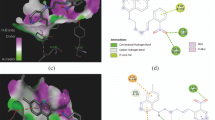Abstract
A novel series of S-, S,S-, N- and N,S-substituted 1,4-naphthoquinone derivatives were synthesized and evaluated for their antibacterial and antifungal activity. Among the synthesized compounds especially 10a and 11b have been discovered as an antibacterial or antifungal agents, and 15f is the most effective compound against M. luteum as potent antifungal. The structures of the novel products were characterized by micro analysis, UV/Vis, 1H NMR, 13C NMR, and MS. The electrochemical properties of some of the novel 1,4-naphthoquinone derivatives were also investigated by cyclic voltammetry.
Graphical Abstract




Similar content being viewed by others
References
Corral JMG, Castro MA, Gordaliza M, Martín ML, Gamito AM, Cuevas C, Feliciano AS (2006) Synthesis and cytotoxicity of new heterocyclic terpenylnaphthoquinones. Bioorg Med Chem 14:2816–2827
Guin PS, Das S, Mandal PC (2011) Electrochemical reduction of quinones in different media: a review. Int J of Electrochem 2011:1–22. doi:10.4061/2011/816202
Huang LJ, Chang FC, Lee KH, Wang JP, Teng CM, Kuo SC (1998) Synthesis and antiplatelet, antiinflammatory, and antiallergic activities of substituted 3-chloro-5,8-dimethoxy-1,4-naphthoquinone and related compounds. Bioorg Med Chem 6:2261–2269
Huang P, Feng L, Olgham EA, Keating MJ, Plunkess W (2000) Superoxide dismutase as a target for the selective killing of cancer cells. Nature 407:390–395
Ibis C, Sahinler Ayla S (2011) Synthesis and spectroscopic evaluation of novel N-, S-, and O-substituted 1,4-naphthoquinone derivatives. Phosphorur Sulfur Silicon 186:2350–2356
Ibis C, Tuyun AF, Ozsoy-Gunes Z, Bahar H, Stasevych MV, Musyanovych R, Komarovska-Porokhnyavets O, Novikov V (2011) Synthesis and biological evaluation of novel nitrogen- and sulfurcontaining hetero-1,4-naphthoquinones as potent antifungal and antibacterial agents. Eur J Med Chem 46:5861–5867
Ibis C, Tuyun AF, Ozsoy Gunes Z, Sahinler Ayla S, Stasevych MV, Musyanovych R, Komarovska Porokhnyavets O, Novikov V (2013a) Synthesis and antibacterial and antifungal properties of novel S-, N-, N,S- and S,O-substituted 1,4-naphthoquinone derivatives. Phosphorur Sulfur Silicon 188:955–966
Ibis C, Tuyun AF, Bahar H, Sahinler Ayla S, Stasevych MV, Musyanovych R, Komarovska Porokhnyavets O, Novikov V (2013b) Synthesis of novel 1,4-naphthoquinone derivatives: antibacterial and antifungal agents. Med Chem Res 22:2879–2888
Kim HS, Chung TD, Kim H (2001) Voltammetric determination of the pKa of various acids in polar aprotic solvents using 1,4-benzoquinone. J Electroanal Chem 498:209–215
Levin JI, Chen JM, Laakso LM, Du M, Schmid J, Xu W, Cummons T, Xu J, Jin G, Barone D, Skotnicki JS (2006) Acetylenic TACE inhibitors. Part 3: Thiomorpholine sulfonamide hydroxamates. Bioorg Med Chem Lett 16:1605–1609
Lien JC, Huang LJ, Teng CM, Wang JP, Kuo SC (2002) Synthesis of 2-alkoxy 1,4-naphthoquinone derivatives as antiplatelet, antiinflammatroy and antiallergic agents. Chem Pharm Bull 50:672–674
Milczarska B, Foks H, Zwolska Z (2005) Studies on pyrazine derivatives, XLII: synthesis and tuberculostatic activity of 6-(1,4-dioxa-8-azaspiro-[4,5]-decano)- and 6-(1-ethoxycarbonylpiperazino)-pyrazinocarboxylic acid derivatives. Phosphorus Sulfur Silicon 180:1977–1992
Murray PR, Baron EJ, Pfaller MA, Tenover FC, Yolken RH (1995) Manual of clinical microbiology, 6th edn. ASM Press, Washington, pp 1327–1341
National Committee for Clinical Laboratory Standard (1998) Reference method for broth dilution antifungal susceptibility testing of conidium forming filamentous fungi: proposed standard, document M38-P. National Committee for Clinical Laboratory Standard, Wayne
Ngampong K, Boonsong K, Pongpun S, Chak S, Suwaporn L, Momad N, Suppachai P, Suratsawadee P, Palangpon K (2003) Potent antitumor activity of synthetic 1,2-naphthoquinones and 1,4-naphthoquinones. Bioorg Med Chem 11:3179–3191
Ojima I, Kuduk SD, Pera P, Veith JM, Bernacki RJ (1997) Synthesis and structure–activity relationships of nonaromatic taxoids: effects of alkyl and alkenyl ester groups on cytotoxicity. J Med Chem 40:279–285
Oku H, Kato T, Ishiguro K (2002) Antipruritic effects of 1,4-naphthoquinones and related compounds. Biol Pharm Bull 25:137–139
Olma A, Lasota A, Kudaj A (2012) A convenient route to optically pure a-alkyl-b-(sec-amino)alanines. Amino Acids 42:2525–2528
Pedersen SU, Christensen TB, Thomasen T, Daasbjerg K (1998) New methods for the accurate determination of extinction and diffusion coefficients of aromatic and heteroaromatic radical anions in N,N-dimethylformamide. J Electroanal Chem 454:123–143
Perez-Sacau E, Diaz-Penate R, Estevez-Braun A, Ravelo AG, Garcia-Castellano J, Pardo L, Campillo M (2007) Synthesis and pharmacophore modeling of naphthoquinone derivatives with cytotoxic activity in human promyelocytic leukemia HL-60 cell line. J Med Chem 50:696–706
Verma RP (2006) Anti-cancer activities of 1,4-naphthoquinones: a QSAR study. Anti Cancer Agents Med Chem 6:489–499
Acknowledgments
The financial support from TUBITAK for Ukraine–Turkey agreement gratefully acknowledged (Project No. 109T617) and from State Agency on Science, Innovations and Informatization of Ukraine (Project No. M/309-2011).
Author information
Authors and Affiliations
Corresponding author
Rights and permissions
About this article
Cite this article
Ibis, C., Tuyun, A.F., Bahar, H. et al. Nucleophilic substitution reactions of 1,4-naphthoquinone and biologic properties of novel S-, S,S-, N-, and N,S-substituted 1,4-naphthoquinone derivatives. Med Chem Res 23, 2140–2149 (2014). https://doi.org/10.1007/s00044-013-0806-y
Received:
Accepted:
Published:
Issue Date:
DOI: https://doi.org/10.1007/s00044-013-0806-y




